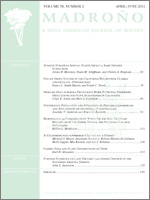Cryptic self-incompatibility (CSI) is a type of non-random mating observed in self-compatible plants in which outcross pollen sires proportionally more seeds than self pollen when both pollen types are available on the stigma. Levels of CSI are known to vary among individuals and populations. We conducted competitive pollinations consisting of mixtures of self and outcross pollen to investigate reports of CSI in certain populations of Clarkia unguiculata Lindl. We also investigated how the order of self and outcross pollen deposition on the stigma influences the degree of nonrandom mating. Finally, we looked at whether the source population of outcross pollen affected the ability of outcross pollen to outcompete self pollen. We utilized recessive (white-petaled) maternal (and self pollen donor) plants from a locality near Morro Bay, California, and dominant (pink-petaled) outcross pollen donor plants from 17 localities widespread through the species range in California. Progenies from pollinations made with equal mixtures of self and cross pollen included significantly more outcross-pollinated than self-pollinated offspring in 10 of the 17 cross-pollen donor populations. However six populations showed no significant difference between self- and outcross-pollinated offspring, and one population yielded a majority of progeny sired by self pollen. Progenies from sequential self pollen followed by outcross pollinations included significantly more self offspring in 12 of the donor populations, no significant difference between outcross and self offspring in four donor populations and significantly more outcross offspring in one donor population. Progenies from sequential outcross pollen followed by self pollinations included significantly more outcross offspring in 15 donor populations and no significant difference between outcross and self offspring in two donor populations. Our results confirm the occurrence of non-random mating in C. unguiculata, and demonstrate that the degree of non-random mating can depend on the order of self vs. outcross pollen deposition and the source population of outcross pollen. This non-random mating can influence the proportion of self and outcross progeny in sequential pollinations.
How to translate text using browser tools
1 April 2011
Pollen Siring Success in the California Wildflower Clarkia unguiculata (Onagraceae)
ACCESS THE FULL ARTICLE

Madroño
Vol. 58 • No. 2
April 2011
Vol. 58 • No. 2
April 2011
Clarkia unguiculata
cryptic self-incompatibility
geitonogamy
non-random mating
sexual conflict




